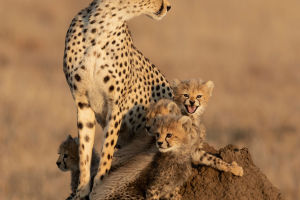Lions, one of the most iconic animals in nature, have long occupied a prominent place in our culture, history, and imagination.
Not only are they at the top of the predator chain, but they also symbolize strength, courage, and kingship. From their habits on the African savannah to their images in myth and literature, lions represent much more than just ordinary wild animals.
Lions are a member of the cat family, related to animals such as tigers and leopards. They are widely distributed in sub-Saharan Africa, and a small number of groups also live in the Gir Forest of India. Unlike other cats, lions are social animals, usually forming family groups. A typical lion pride consists of several adult lionesses and their cubs, while adult male lions may act alone or in pairs, responsible for protecting the territory and the lion group from outside enemies. Lionesses are responsible for hunting and raising their offspring. This cooperative group structure is key to their survival in the harsh natural environment.
Lion Cubs Are Introduced To Their Father | Predator Perspective | Love Nature
Video by Love Nature
Lions usually live in grasslands, savannas, and open bushes, which allow them to hunt by stealth and teamwork. Lions mainly feed on large herbivores such as zebras, wildebeests, and buffaloes. Their hunting strategy is very clever, often using the cover of grass to lurk near the prey, and then the lions will attack and surround the prey in coordination. This highly organized hunting method is closely related to their group lifestyle. Although lions are known as the "king of beasts", their hunting success rate is not high, and they often rely on patience and teamwork.
Lions are huge, with the average weight of male lions reaching 250 kilograms, while female lions are lighter and usually weigh around 150 kilograms. The appearance of lions is very striking, especially male lions, and the manes on their heads make them more majestic visually.
The color and thickness of the male lion's mane are often considered a symbol of its health and strength, and the mane is usually thicker in colder environments. This is not only a protective mechanism, the mane can also protect the head and neck in battle.
Although lions seem fearless, they face no shortage of threats to their survival. Habitat reduction and human activities are seriously threatening the survival of lion populations. As more and more land on the African savannah is reclaimed for agriculture and animal husbandry, the range of lions is shrinking. This habitat loss has made conflicts between lions and humans more frequent. On the one hand, lions sometimes attack livestock, leading farmers to retaliate against them; on the other hand, the activities of poachers have also made the survival of lions more difficult. Although lion parts, such as fur and bones, are no longer as widely used as in the past, their lives are still threatened by illegal hunting.
In addition to the survival dilemma in reality, the status of lions in human culture is also very important. In many cultures, lions are regarded as symbols of strength, courage, and kingship.
Lions also often play an important role in literary works. For example, In Shakespeare's play "Measure for Measure", the image of the lion is used to metaphorically represent the strong power of human emotions. Through these works, the image of the lion has been preserved and constantly given new meanings.
From the magnificent appearance of lions to their complex social structure and their profound symbolic significance in culture, lions are undoubtedly one of the most awe-inspiring creatures on earth. However, their future is still full of uncertainty.
Only through better protection measures and global joint efforts can we ensure that this great creature can continue to survive on the earth and continue to inspire awe and inspiration in the years to come.


